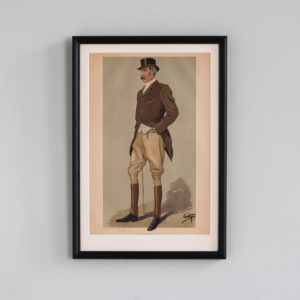6 items found
Page 1 of 1
-

Brass model of a rearing horse,
£400 -

A Muddy, a Sketch in Bond Street.
£220A Muddy, a Sketch in Bond Street.
A hand coloured etching by Isaac Cruikshank. A landau coach, nicknamed a 'Muddy' bespattered with grime, halts in Bond street, as two ladies look out of the window to chat with two fashionably dressed gentlemen. The coach driver is protected by a curtained seat, and two tall liveried attendants stand at the rear, eyeing the exchange archly. Before the rise and triumphant progress of Napoleon Bonaparte sparked a patriotic reaction in Britain, the circle of caricaturists and cartoonists working in London took their aim at the perceived voluptuary tendencies of the fashionable establishment in London. The French Wars and the Revolution had led to a period of social and economic hardship in Britain which seemingly left only the wealthy and well-connected untouched. Here Isaac Cruikshank takes aim at the folly and vice of a self-indulgent set. Isaac Cruikshank was the son of a dispossessed Jacobite customs inspector. After leaving Edinburgh for London in 1783 he sustained a precarious existence as an artist and caricaturist and, along with James Gillray and Thomas Rowlandson, contributed to what has been called 'the golden age of British caricature'. Isaac Cruikshank died of alcohol poisoning after a winning a drinking contest one evening in 1811. Two of his sons Isaac Robert Cruikshank, and George Cruikshank carried on the family tradition into the middle of the 19th Century.£220 -

William Nicholson, Sports as Months of the Year
£195 -

A hard rider,
£190A hard rider,
Framed Chromolithograph by SPY (Sir Leslie Ward) picturing 'Captain' David Longfield Beatty, infamous soldier and amateur sportsman of the late Victorian period. An Anglo-Irish horse dealer and trainer from County Wexford, Captain Beatty was considered a violent and unpleasant bully. After cuckolding a brother Officer in the 4th Hussars he was dismissed from his regiment although he continued to be referred to as 'Captain' - a rank he had never achieved and held only in an honorary capacity. His natural son, David Richard Beatty went on to become Admiral of the Fleet and the 1st Earl Beatty, Viscount Borodale and Baron Beatty of the North Sea and Brooksby sometimes described as 'Britain's last naval hero'.£190 -

Londres Secret et Ses Fantomes, lithographs published 1946
£140 eachLondres Secret et Ses Fantomes, lithographs published 1946
Serges was a Circus Chronicler, Graphic Artist, Painter and Radio Broadcaster. Although, a born and bred Parisian he had a great affection for London, a city to which he dedicated this work. They show alongside the well-known landmarks, the seamy underbelly of prostitutes, pub singers, seamen and drunks. Mounted and framed in natural oak.£140 each -

Londres Secret et Ses Fantomes, lithographs published 1946
£140 eachLondres Secret et Ses Fantomes, lithographs published 1946
Serges was a Circus Chronicler, Graphic Artist, Painter and Radio Broadcaster. Although, a born and bred Parisian he had a great affection for London, a city to which he dedicated this work. They show alongside the well-known landmarks, the seamy underbelly of prostitutes, pub singers, seamen and drunks. Mounted and framed in natural oak.£140 each
Featured Items
-

Printemps by Marc Chagall, Verve Vol. 1 / No. 3.
£800Printemps by Marc Chagall, Verve Vol. 1 / No. 3.
The Verve Review was a purposefully luxurious. It ran from 1937 to 1960, but with only 38 editions available, due to the high degree of design and editorial work dedicated to each issue. Each edition contained unique lithographic prints, commissioned by the editor, and each cover a double-page lithograph elaborated by one of the artists contained within. It was the brainchild of its editor Stratis Eleftheriades, a Greek National who moved to Paris in the early thirties to take part in the growing Modernist movement, writing under the name of Teriade.£800 -

The Four Elements, Earth by Francisco Bores, Verve Vol. 1 / No. 1.
£600The Four Elements, Earth by Francisco Bores, Verve Vol. 1 / No. 1.
The Verve Review was a purposefully luxurious. It ran from 1937 to 1960, but with only 38 editions available, due to the high degree of design and editorial work dedicated to each issue. Each edition contained unique lithographic prints, commissioned by the editor, and each cover a double-page lithograph elaborated by one of the artists contained within. It was the brainchild of its editor Stratis Eleftheriades, a Greek National who moved to Paris in the early thirties to take part in the growing Modernist movement, writing under the name of Teriade.£600 -

Stars by Wassily Kandinsky, Verve Vol. 1 / No. 2.
£800Stars by Wassily Kandinsky, Verve Vol. 1 / No. 2.
The Verve Review was a purposefully luxurious. It ran from 1937 to 1960, but with only 38 editions available, due to the high degree of design and editorial work dedicated to each issue. Each edition contained unique lithographic prints, commissioned by the editor, and each cover a double-page lithograph elaborated by one of the artists contained within. It was the brainchild of its editor Stratis Eleftheriades, a Greek National who moved to Paris in the early thirties to take part in the growing Modernist movement, writing under the name of Teriade.£800 -

Head of a Girl by George Rouault, Verve Vol 2 / No. 5-6.
£800Head of a Girl by George Rouault, Verve Vol 2 / No. 5-6.
The Verve Review was a purposefully luxurious. It ran from 1937 to 1960, but with only 38 editions available, due to the high degree of design and editorial work dedicated to each issue. Each edition contained unique lithographic prints, commissioned by the editor, and each cover a double-page lithograph elaborated by one of the artists contained within. It was the brainchild of its editor Stratis Eleftheriades, a Greek National who moved to Paris in the early thirties to take part in the growing Modernist movement, writing under the name of Teriade.£800
